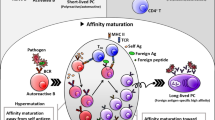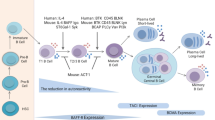Abstract
It is crucial for the immune system to minimise the number of circulating mature self-reactive B cells, in order to reduce the potential for the development of autoantibody-related autoimmune diseases. Studies of animal models have identified two major checkpoints that ensure that such cells do not contribute to the naïve B cell repertoire. The first is in the bone marrow as B cells develop and the second is in the spleen; B cells that are released from the bone marrow as transitional B cells go through more stringent selection in the spleen before they develop into mature naïve B cells. Transitional B cells and their maturation have mostly been studied in mice. However, recent studies characterised human transitional B cells and found considerable differences to current models. In this review, we will consider these differences alongside known differences in mouse and human splenic function and ask whether human transitional B cells might develop along a different pathway.

Similar content being viewed by others
References
Allman D, Lindsley RC, DeMuth W et al (2001) Resolution of three nonproliferative immature splenic B cell subsets reveals multiple selection points during peripheral B cell maturation. J Immunol 167:6834–6840
Aranburu A, Ceccarelli S, Giorda E et al (2010) TLR ligation triggers somatic hypermutation in transitional B cells inducing the generation of IgM memory B cells. J Immunol 185:7293–7301
Brink R, Goodnow CC, Crosbie J et al (1992) Immunoglobulin M and D antigen receptors are both capable of mediating B lymphocyte activation, deletion, or anergy after interaction with specific antigen. J Exp Med 176:991–1005
Capolunghi F, Cascioli S, Giorda E et al (2008) CpG drives human transitional B cells to terminal differentiation and production of natural antibodies. J Immunol 180:800–808
Cariappa A, Tang M, Parng C et al (2001) The follicular versus marginal zone B lymphocyte cell fate decision is regulated by Aiolos, Btk, and CD21. Immunity 14:603–615
Cariappa A, Chase C, Liu H et al (2007) Naive recirculating B cells mature simultaneously in the spleen and bone marrow. Blood 109:2339–2345
Carsetti R (2000) The development of B cells in the bone marrow is controlled by the balance between cell-autonomous mechanisms and signals from the microenvironment. J Exp Med 191:5–8
Cesta MF (2006) Normal structure, function, and histology of the spleen. Toxicol Pathol 34:455–465
Chopin M, Quemeneur L, Ripich T et al (2010) SWAP-70 controls formation of the splenic marginal zone through regulating T1B-cell differentiation. Eur J Immunol 40:3544–3556
Crivellato E, Vacca A, Ribatti D (2004) Setting the stage: an anatomist’s view of the immune system. Trends Immunol 25:210–217
de Weers M, Verschuren MC, Kraakman ME et al (1993) The Bruton’s tyrosine kinase gene is expressed throughout B cell differentiation, from early precursor B cell stages preceding immunoglobulin gene rearrangement up to mature B cell stages. Eur J Immunol 23:3109–3114
Dunn-Walters DK, Isaacson PG, Spencer J (1995) Analysis of mutations in immunoglobulin heavy chain variable region genes of microdissected marginal zone (MGZ) B cells suggests that the MGZ of human spleen is a reservoir of memory B cells. J Exp Med 182:559–566
Freedman AS, Freeman G, Whitman J et al (1989) Studies of in vitro activated CD5+ B cells. Blood 73:202–208
Gale RP (1987) Development of the immune system in human fetal liver. Thymus 10:45–56
Gay D, Saunders T, Camper S et al (1993) Receptor editing: an approach by autoreactive B cells to escape tolerance. J Exp Med 177:999–1008
Griffin DO, Holodick NE, Rothstein TL (2011) Human B1 cells in umbilical cord and adult peripheral blood express the novel phenotype CD20+ CD27+ CD43+ CD70−. J Exp Med 208:67–80
Harless SM, Lentz VM, Sah AP et al (2001) Competition for BLyS-mediated signaling through Bcmd/BR3 regulates peripheral B lymphocyte numbers. Curr Biol 11:1986–1989
Hartley SB, Crosbie J, Brink R et al (1991) Elimination from peripheral lymphoid tissues of self-reactive B lymphocytes recognizing membrane-bound antigens. Nature 353:765–769
Hemmi H, Takeuchi O, Kawai T et al (2000) A toll-like receptor recognizes bacterial DNA. Nature 408:740–745
Henderson RB, Grys K, Vehlow A et al (2010) A novel Rac-dependent checkpoint in B cell development controls entry into the splenic white pulp and cell survival. J Exp Med 207:837–853
Hornung V, Rothenfusser S, Britsch S et al (2002) Quantitative expression of toll-like receptor 1–10 mRNA in cellular subsets of human peripheral blood mononuclear cells and sensitivity to CpG oligodeoxynucleotides. J Immunol 168:4531–4537
Klein U, Kuppers R, Rajewsky K (1997) Evidence for a large compartment of IgM-expressing memory B cells in humans. Blood 89:1288–1298
Liu YJ, Oldfield S, MacLennan IC (1988) Memory B cells in T cell-dependent antibody responses colonize the splenic marginal zones. Eur J Immunol 18:355–362
Lo CG, Lu TT, Cyster JG (2003) Integrin-dependence of lymphocyte entry into the splenic white pulp. J Exp Med 197:353–361
Loder F, Mutschler B, Ray RJ et al (1999) B cell development in the spleen takes place in discrete steps and is determined by the quality of B cell receptor-derived signals. J Exp Med 190:75–89
Mackay F, Figgett WA, Saulep D et al (2010) B-cell stage and context-dependent requirements for survival signals from BAFF and the B-cell receptor. Immunol Rev 237:205–225
Marie-Cardine A, Divay F, Dutot I et al (2008) Transitional B cells in humans: characterization and insight from B lymphocyte reconstitution after hematopoietic stem cell transplantation. Clin Immunol 127:14–25
Martin F, Kearney JF (2000) Positive selection from newly formed to marginal zone B cells depends on the rate of clonal production, CD19, and btk. Immunity 12:39–49
Mebius RE, Kraal G (2005) Structure and function of the spleen. Nat Rev Immunol 5:606–616
Meffre E, Schaefer A, Wardemann H et al (2004) Surrogate light chain expressing human peripheral B cells produce self-reactive antibodies. J Exp Med 199:145–150
Merrell KT, Benschop RJ, Gauld SB et al (2006) Identification of anergic B cells within a wild-type repertoire. Immunity 25:953–962
Nemazee D, Buerki K (1989) Clonal deletion of autoreactive B lymphocytes in bone marrow chimeras. Proc Natl Acad Sci USA 86:8039–8043
Nemazee DA, Burki K (1989) Clonal deletion of B lymphocytes in a transgenic mouse bearing anti-MHC class I antibody genes. Nature 337:562–566
Palanichamy A, Barnard J, Zheng B et al (2009) Novel human transitional B cell populations revealed by B cell depletion therapy. J Immunol 182:5982–5993
Rolink A, Haasner D, Nishikawa S et al (1993) Changes in frequencies of clonable pre B cells during life in different lymphoid organs of mice. Blood 81:2290–2300
Rosado MM, Aranburu A, Capolunghi F et al (2009) From the fetal liver to spleen and gut: the highway to natural antibody. Mucosal Immunol 2:351–361
Sims GP, Ettinger R, Shirota Y et al (2005) Identification and characterization of circulating human transitional B cells. Blood 105:4390–4398
Srivastava B, Quinn WJ 3rd, Hazard K et al (2005) Characterization of marginal zone B cell precursors. J Exp Med 202:1225–1234
Steiniger B, Barth P, Hellinger A (2001) The perifollicular and marginal zones of the human splenic white pulp: do fibroblasts guide lymphocyte immigration? Am J Pathol 159:501–512
Suryani S, Fulcher DA, Santner-Nanan B et al (2010) Differential expression of CD21 identifies developmentally and functionally distinct subsets of human transitional B cells. Blood 115:519–529
Teague BN, Pan Y, Mudd PA et al (2007) Cutting edge: Transitional T3 B cells do not give rise to mature B cells, have undergone selection, and are reduced in murine lupus. J Immunol 178:7511–7515
Timens W, Boes A, Rozeboom-Uiterwijk T et al (1989) Immaturity of the human splenic marginal zone in infancy. Possible contribution to the deficient infant immune response. J Immunol 143:3200–3206
Tze LE, Schram BR, Lam KP et al (2005) Basal immunoglobulin signaling actively maintains developmental stage in immature B cells. PLoS Biol 3:e82
Vetrie D, Vorechovsky I, Sideras P et al (1993) The gene involved in X-linked agammaglobulinaemia is a member of the src family of protein-tyrosine kinases. Nature 361:226–233
Wardemann H, Yurasov S, Schaefer A et al (2003) Predominant autoantibody production by early human B cell precursors. Science 301:1374–1377
Weill JC, Weller S, Reynaud CA (2009) Human marginal zone B cells. Annu Rev Immunol 27:267–285
Wilkins BS, Wright DH (2000) Illustrated pathology of the spleen. Cambridge University Press, Cambridge
Wu YC, Kipling D, Leong HS et al (2010) High-throughput immunoglobulin repertoire analysis distinguishes between human IgM memory and switched memory B-cell populations. Blood 116:1070–1078
Yurasov S, Wardemann H, Hammersen J et al (2005) Defective B cell tolerance checkpoints in systemic lupus erythematosus. J Exp Med 201:703–711
Acknowledgments
A. Vossenkämper is funded by the Medical Research Council, UK.
Conflict of interest
The authors declare no conflict of interest.
Author information
Authors and Affiliations
Corresponding author
About this article
Cite this article
Vossenkämper, A., Spencer, J. Transitional B Cells: How Well Are the Checkpoints for Specificity Understood?. Arch. Immunol. Ther. Exp. 59, 379 (2011). https://doi.org/10.1007/s00005-011-0135-0
Received:
Accepted:
Published:
DOI: https://doi.org/10.1007/s00005-011-0135-0




